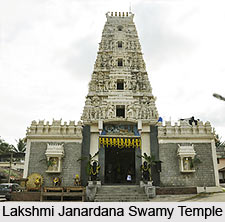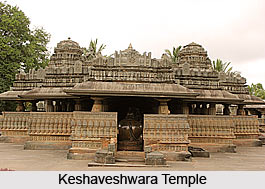 The temples of Hassan District reflect the famous Hoysala architecture. The district Hassan lies to the west of Bangalore. Hassan district is famous for its temples built during Hoysala period. A Chola officer called Bukkanna Nayaka founded the district during 11th Century and got established during 12th century. The Hasanamba temple of Goddess Hasanamma was constructed during Sanjeeva Krishnappa Nayaka period, which is a structure of, post Vijayanagar period. This temple is one of the most revered temples of Hassan District and is opened only once in a year for the period of one week.
The temples of Hassan District reflect the famous Hoysala architecture. The district Hassan lies to the west of Bangalore. Hassan district is famous for its temples built during Hoysala period. A Chola officer called Bukkanna Nayaka founded the district during 11th Century and got established during 12th century. The Hasanamba temple of Goddess Hasanamma was constructed during Sanjeeva Krishnappa Nayaka period, which is a structure of, post Vijayanagar period. This temple is one of the most revered temples of Hassan District and is opened only once in a year for the period of one week.
Some of the important temples of Hassan District are Chennakesava Temple, Keshaveshwara Temple, Lakshminarayana Temple, Hoyasaleswara Temple and Lakshmi Janardana Swamy Temple. The Chennakesava Temple is one of the main temples of Hassan District, located at Belur and was built by a local ruler, who belonged to the Hoysala dynasty during the 11th century to honor the victory of the Hoysala`s over the Cholas at Talakad. The temple is remarkably large and most of the decorations were added later during the 12th and 14th centuries. The temple is enclosed in a paved compound that includes a well and a water tank. The Chennakesava Temple also consists of a shrine, an open hall and a platform and is built in the typical Hoysala architectural style.
Lakshmi Venkataramana Swamy Temple, one of the temples of Hassan District is situated at Amaragiri Malekal Tirupati Hill near Arsikere. The presiding deity of this temple is Lord Vishnu, along with His consort Goddess Lakshmi.
 Here Lord Vishnu is widely known as Venkataramana Swamy. The temple is characterised by a calm and charming ambience. An annual fair called the Brahmarathotsava is pompously celebrated here with great entertainment and splendor.
Here Lord Vishnu is widely known as Venkataramana Swamy. The temple is characterised by a calm and charming ambience. An annual fair called the Brahmarathotsava is pompously celebrated here with great entertainment and splendor.
Hoyasaleswara Temple is one of the temples of Hassan District that is dedicated to Lord Shiva. Located in Belur city of Karnatka, the construction of the temple was started in 1121 by Ketamalla, a general of King Vishnu Vardhana of the Hoysala Dynasty, the ruler of the erstwhile kingdom of Mysore, in Karnataka. Hoyasaleswara temple is adorned with sculptures depicting scenes from the Hindu epic Ramayana. Keshaveshwara Temple is one of the popular temples of Hassan District and also known as Betteshwara. This temple is situated at Agraharabelguli in Hassan District and is an exceptional Hoysala structure with complicated artworks and carvings, sanctified by Kesiraja, a commander under the Hoysala Emperor Ballala II, in 1209.
The temples of Hassan District have their own unique characteristics. The main attraction of the Keshaveshwara Temple is the magnificent Keshava image 5 1/2 ft high, installed in the northern Garbhagriha, with four hands each adorned with conch, disc, club and lotus. Within the temple complex one can witness two spaciously decorated porches where a Nandimantapa is attached with a 4 ft tall Nandi. Another notable feature of the temple is the existence of a two-storied mahadwara of the Hoysala period. Besides the mentioned ones, Shantigrama Jain Temple, Javagal Lakshminarasimha Temple and Lakshmi Venkataramana Swamy Temple are the other temples of Hassan District.





















